A “clean” industrial policy: A new concept to respond to multiple challenges
Industrial policy has made a comeback in recent years, mostly due to the difficult economic and fiscal situation in Europe. It involves a variety of economic tools, ranging from increased investments in research and innovation, fiscal policy and trade instruments, as well as sectoral policies, ranging from energy to manufacturing.
Industrial policy tools can be either vertical, targeting specific sectors or firms, or horizontal, applied across the entire economy to facilitate the business environment.[1] At the core of any industrial strategy is the formulation of clear objectives, aimed at steering economic development in a desired direction.[2]
While the EU has prioritised its decarbonisation agenda in the 2019-2024 mandate, the rising energy prices, the cost of living crisis and the challenging geopolitical context, with growing tensions over trade and sustainability policies, has led to a shift in priorities.
Rather than leaving aside the climate agenda, the EU decided to link both its competitiveness and economic security agenda with sustainability policy – and use industrial policy as a pathway towards a low-carbon, circular economy. This way, the EU will be able to reach its legally binding climate neutrality targets by 2050.
However, reaching these objectives will be a challenging endeavour. The EU needs to balance decarbonisation efforts with economic security and competitiveness. It will have to use the full arsenal of existing measures and tools at its disposal – and ensure there is sufficient investment to allow for this “clean” transition to happen rapidly.
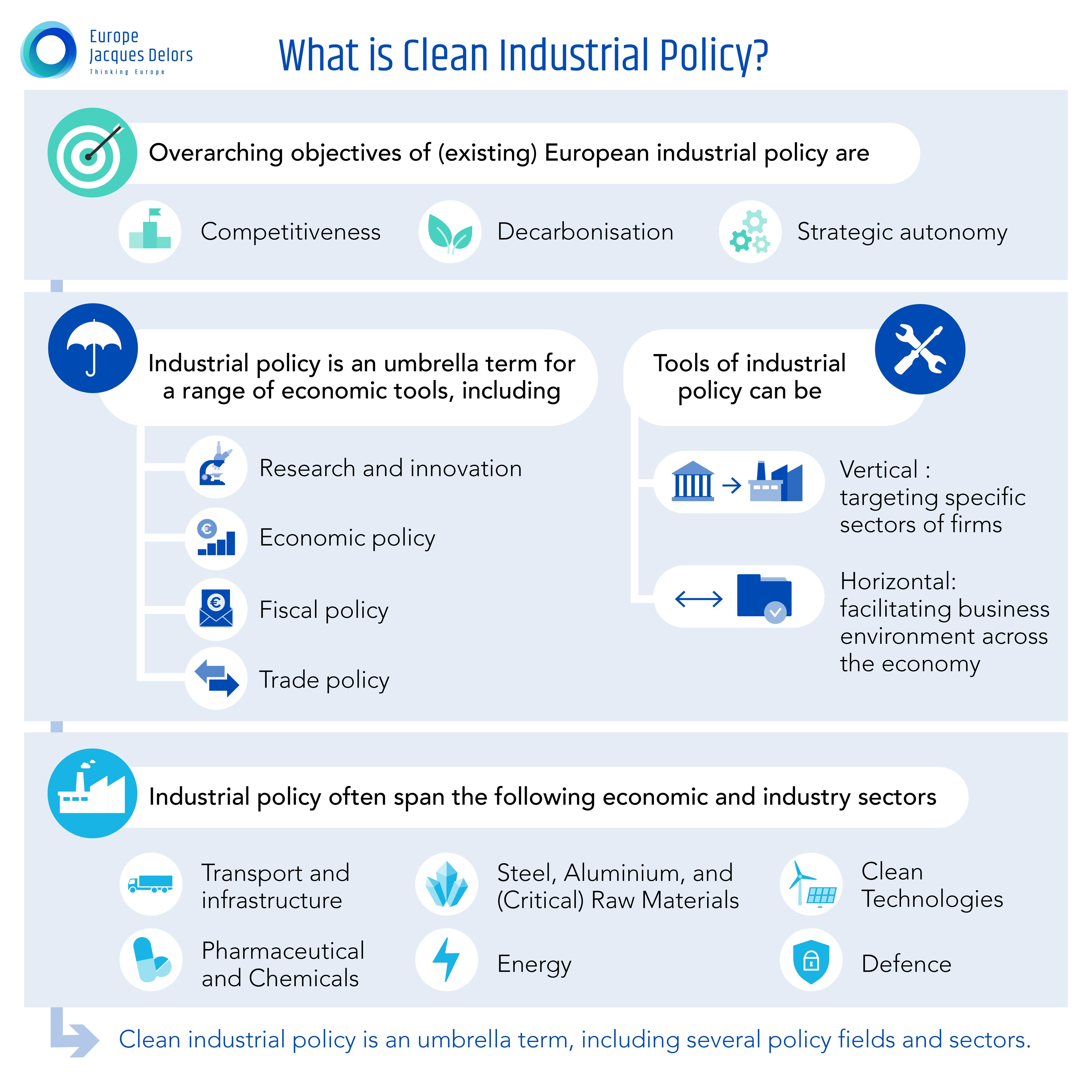
The Clean Industrial Deal will be one pillar of the EU’s new Competitiveness Compass
The Clean Industrial Deal will be one of the pillars of the announced “Competitiveness Compass”. Commission President von der Leyen takes over the suggestions of the Draghi report by following its three pillars:
- closing the innovation gap with the US and China;
- presenting a joint plan for decarbonisation and competitiveness, the Clean Industrial Deal;
- and a focus on economic security to reduce excessive dependencies.
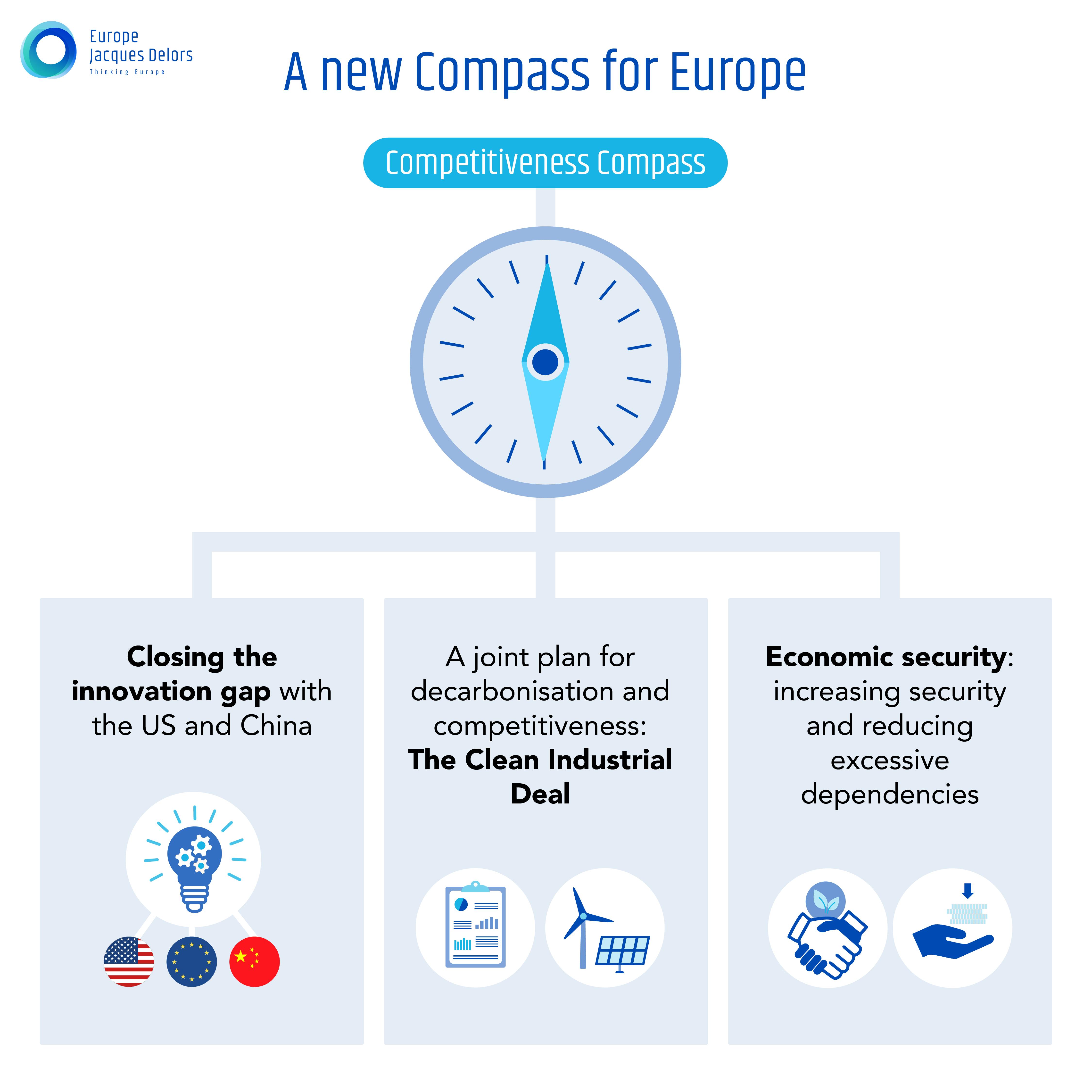
The Clean Industrial Deal: What we know so far in terms of policies and governance
While the exact contents of the Clean Industrial Deal are still unknown, it is possible to gain a first understanding of its contents and governance structures from closer examination of the Commission’s Political Guidelines, the Mission Letters, and the confirmation hearings.
- An Action Plan for Affordable Energy Prices is expected to be presented along with the Clean Industrial Deal to lay out measures to bring down prices in the short and medium term. According to the Mission Letters, it will be presented by Energy Commissioner Jørgensen under contribution of namely Executive Vice-President Ribera.
- We can also expect an Electrification Action Plan from Energy Commissioner Jørgensen.
- Climate Commissioner Wopke Hoekstra is further missioned to conclude the Revision of the Energy Taxation Directive and explore “how to further green the VAT system”.
- The Industrial Decarbonisation Accelerator Act is expected to act similar to NZIA for energy intensive industries in terms of accelerating permitting. It will be presented by Executive Vice-President Séjourné under contribution of namely Climate Commissioner Hoekstra.
- Green Lead Markets are expected to become a central element of the CID to support the development, production and diffusion of clean technology. Creating green lead markets includes taking measures to boost demand, which could be part of the planned revision of the Public Procurement Directive that Executive Vice-President Séjourné is charged with.
- Climate Commissioner Hoekstra is further missioned to “accelerate the build-up of a Single Market for CO2“, building on the existing Industrial Carbon Management Strategy.
- Environment Commissioner Roswall will lead the work on the Circular Economy Act to “create market demand for secondary materials and establish a single market for waste” under contribution of namely Executive Vice-President Séjourné.
- In the same constellation, a new Chemicals Industry Package will be developed as part of the CID, aimed at simplifying REACH and “provid[ing] clarity on PFAS”.
- Under the CID, the Commission intends to speed up and simplify IPCEIs, an endeavour that Executive Vice-Presidents Séjourné and Ribera will be charged with.
- Executive Vice-President Séjourné further is charged to lead the work on risk absorbing measures, ensuring continued implementation of the InvestEU programme.
- Finally, on the external dimension, Trade Commissioner Šefčovič is missioned to develop new Clean Trade and Investment Partnerships, also under contribution by Climate Commissioner Hoekstra.
In parallel to the development of the Clean Industrial Deal, the implementation of the 2030 targets is set to continue, and will be complemented by a 2040 climate target, laying the groundwork for a post-2030-framework.
In terms of governance, many central initiatives fall under the responsibility of more than one Commissioner (indicated through stripes with the colour-coded puzzle pieces). This will require good coordination between services and clear reporting structures.
As space for coordination, the Commission President has launched fourteen Commissioner’s Project Group, with one on the Clean Industrial Deal. It counts ten members, six of which are mandated to develop policies for the CID in their Mission Letters, and is the only Project Group that is not chaired by one Commissioner, but will be jointly co-chaired by three: Executive Vice-President for Prosperity and Industrial Strategy, Stéphane Séjourné; Executive Vice-President for Clean, Just and Competitive Transition, Teresa Ribera; and Climate Commissioner Wopke Hoekstra.
In this new structure, the Clean Industrial Deal differs significantly from its predecessor, the European Green Deal, which, politically, was primarily developed and coordinated by former Executive Vice-President Frans Timmermans.
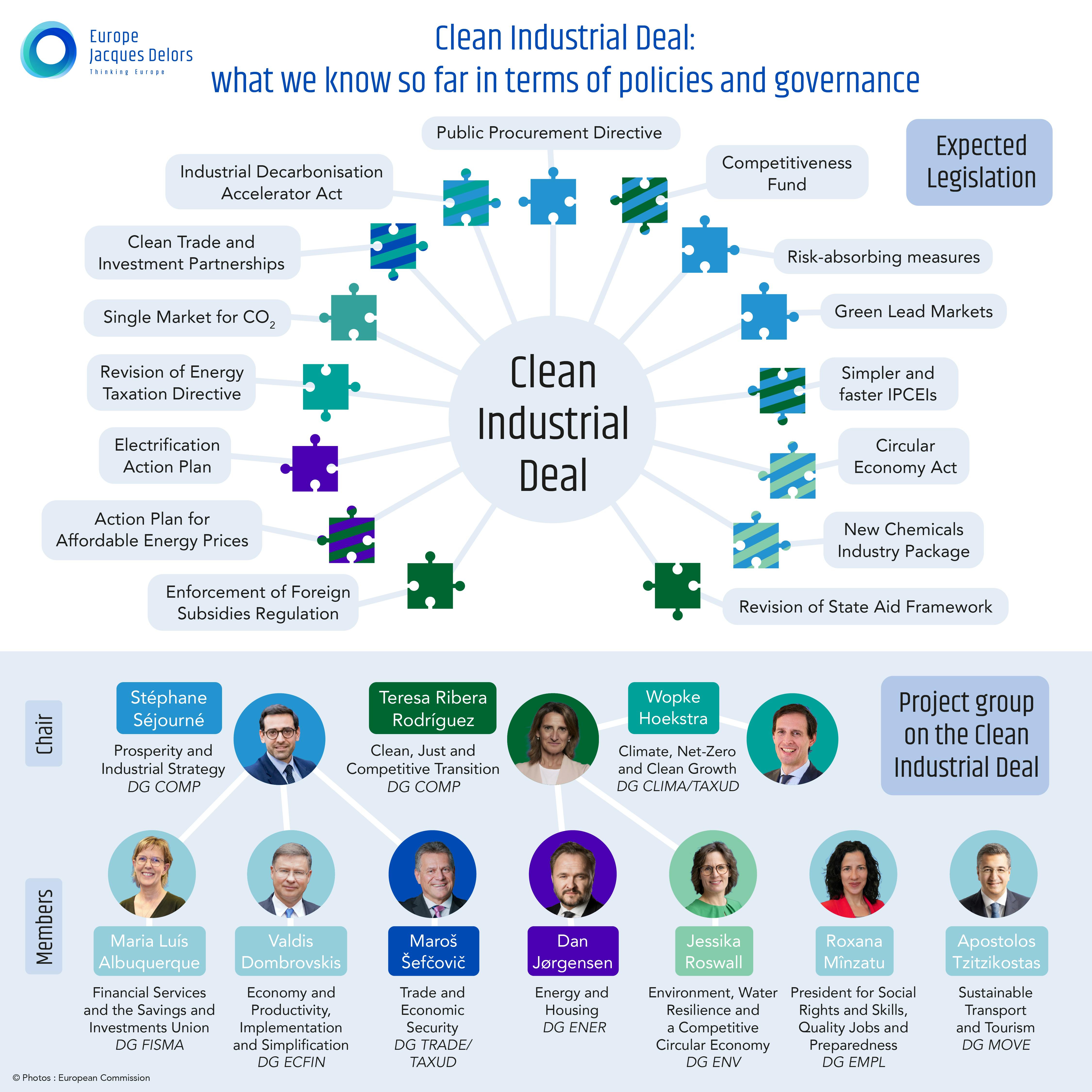
The Clean Industrial Deal: A new EU umbrella framework?
While the EU has an arsenal of instruments at its disposal for an ambitious clean industrial policy, there is no overarching framework for both decarbonisation efforts and industrial policy for now – responsibilities and measures remain divided amongst different Commission services. The Clean industrial Deal could provide an umbrella for the EU’s efforts and better streamline existing policies, therefore also ensuring their coherence.
Building on existing policies
With the European Green Deal (EGD), the EU positioned itself as a leader in climate ambition in 2019. As its centre piece, the European Climate Law enshrines the objective of climate neutrality by 2050. While the European Green Deal has been presented as Europe’s “new growth strategy”, it has not yet been sufficiently backed by measures supporting the transformation of industries, and has only considered social aspects in a very limited scope.[3]
As response to the US American Inflation Reduction Act (IRA), a comprehensive economic agenda put forth by the Biden administration to bolster US clean energy, the EU introduced the Green Deal Industrial Plan in 2023, aimed at strengthening the industrial component of the European Green Deal. This industrial plan was composed of three main initiatives:
- First, the reform of the European electricity market strives to decouple electricity price formation from gas to promote the uptake of renewable energy;
- Second, the Critical Raw Materials Act (CRMA) aims at securing and diversifying supply of critical raw materials which are essential to the manufacturing of clean tech like batteries, wind technologies, or solar PV;
- And, finally, the Net-Zero Industry Act (NZIA) identifies strategic sectors to attract investment and facilitate the scale up of clean manufacturing in the EU, with the objective to build up manufacturing capacities to meet at least 40% of domestic demand in clean tech by domestic production by 2030.
In terms of industrial policy, the Clean Industrial Deal will further build on the REPowerEU package, an energy policy package the EU concluded in response to Russia’s war of aggression to facilitate phase-out of Russian fossil fuel imports. It contains energy efficiency measures, as well as provisions to accelerate the ramp up or renewable energy and related infrastructure. Further, the CID can build on legislation like the European Chips Act which aims to strengthen EU manufacturing capacity in strategic sectors, such as semiconductors.
Building on existing funding mechanisms
While the EU has only limited funding within the Multiannual Financial Framework at its disposal for industrial policy and decarbonisation,[4] there are some funding instruments on which the Clean Industrial Deal can build upon. There are:
- The EU Innovation Fund provides funding for the manufacturing and production of renewable energy, energy storage, carbon capture and utilisation/ and storage (CCU/CCS) through revenues from the EU Emissions Trading System (ETS).
- The European Hydrogen Bank was set up to facilitate the production and imports of renewable hydrogen. Rather than a physical body, the Hydrogen Bank is a funding service run by the European Commission that offers subsidies and financial supports to producers by organizing auctions. To leverage additional funding, it builds on an “auction-as-a-service” scheme, intended to help Member States identify most cost-efficient projects on their own territory.[5]
- The Temporary Crisis and Transition Framework (TCTF) allows Member States to support business in crisis, temporarily bypassing EU State Aid restrictions to invest in sectors of strategic importance for the transition to a net-zero economy, such as renewable energy and storage, manufacturing of green technologies and industrial decarbonisation.
- Important Projects of Common European Interest (IPCEIs) allow Member States to subsidise projects aligned with EU objectives, with greater flexibility from competition law. They have gained in importance for EU industrial policy,[6] and the European Commission has announced a new generation of “simpler and faster” IPCEIs for the new mandate.[7]
- The Recovery and Resilience Facility (RRF) is a funding programme under NextGerneration EU (NGEU), the EU’s response to the COVID-19 crisis. Designed to help Member States to recover from economic fallout during the pandemic and to support reforms, the facility foresees that at least 37% of allocations are spent on measures contributing to climate objectives. Funding under RRF will run out in 2026, if not prolonged or replaced.
- The Strategic Technologies for Europe Platform (STEP) is a platform that creates a “one-stop-shop” to ease access to European funding for strategic projects, such as clean technologies, allowing for the reprogramming of existing EU funding, such as from Cohesion Funds.
- The Just Transition Fund (JTF) is a financial instrument within the EU’s Cohesion Policy aimed at supporting coal, peat and shale oil regions in the transition to a decarbonised economy. It supports reskilling and upskilling, as well as investments in decarbonisation of industry and (clean energy) infrastructure.
- The Connecting Europe Facility (CEF) is a funding instrument that supports infrastructure investments in transport, energy and digital services, aiming to create efficiently interconnected trans-European networks.
- The Second Pillar of Horizon Europe allocates funding for research in the area of Global Challenges and European Industrial Competitiveness, such as industry, space, climate, energy, mobility, or food.
- The InvestEU programme builds on the EU’s Investment Plan for Europe (also known as the ‘Junker Plan’), aimed at de-risking investments in, among others, sustainable transport, energy, digital infrastructure and R&D using EU guarantees.
Building on existing dialogue formats
The European Commission will built on best practices in terms of consultation processes: Under the leadership of DG GROW, the EU has launched eleven Industrial Alliances, which bring together the private sector, social partners, as well as national authorities, Commission representatives and the European Investment Bank (EIB). These alliances discuss different industry sectors, such as batteries, raw materials, and clean hydrogen, and are aimed at fostering exchange and collaboration among stakeholders to enable joint action to reach EU policy objectives.
In addition, the Commission led nine cross-sectoral “Clean Transition Dialogues” on horizontal issues, such as financing and energy prices. The Clean Industrial Deal is likely to build on these experiences and follow a sectoral approach, starting with a strategic dialogue on the future of the automotive sector.
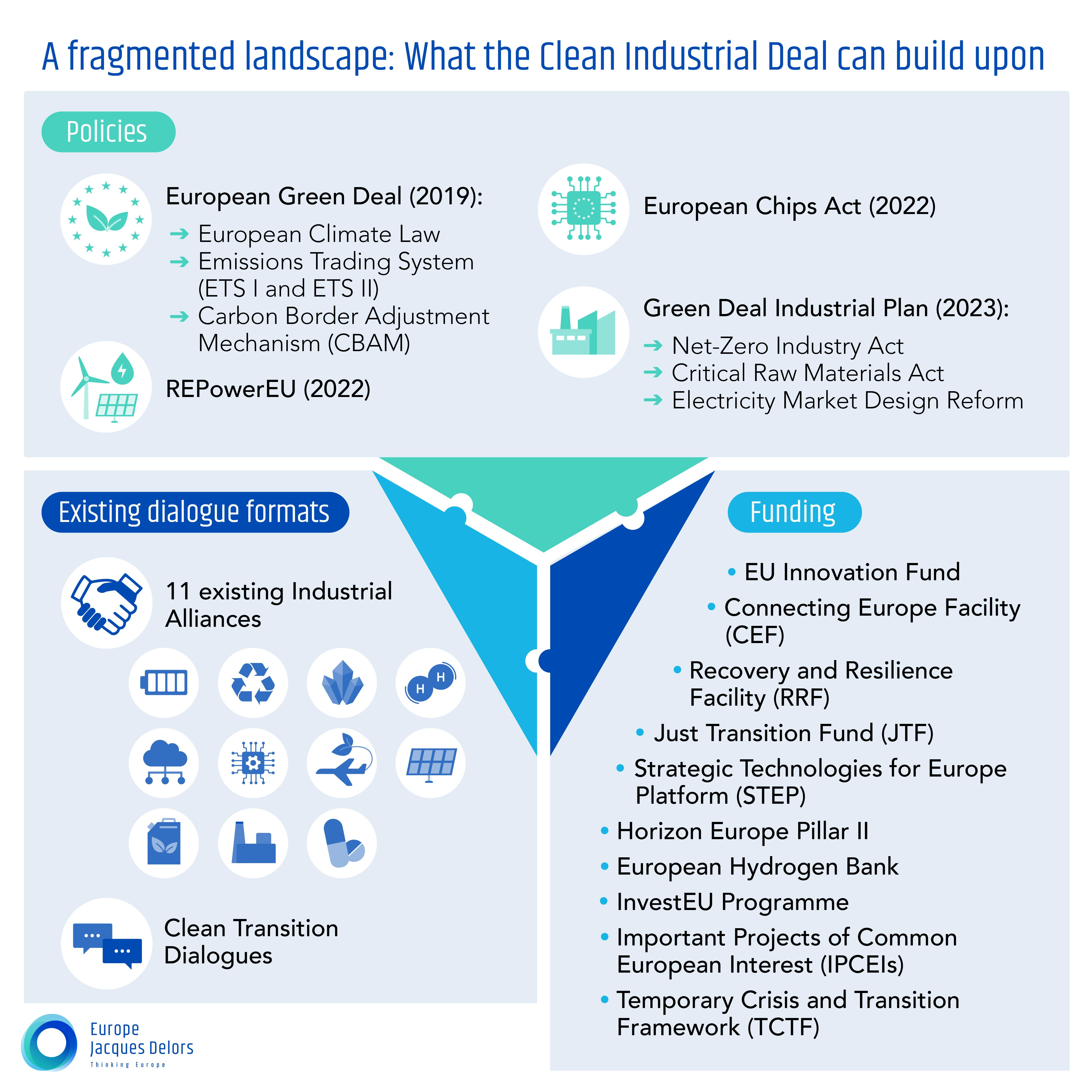
How to implement a clean and just industrial transformation
The transition to an economy that is competitive and decarbonised is a complex endeavour that will require the EU institutions to bring together various “puzzle pieces”.
- First, the overarching financial framework must be supportive of the transition. This will require a review of subsidies to avoid lock-ins in carbon-intensive investments, stronger climate mainstreaming in the next Multiannual Financial Framework (MFF), and a broader use of the ‘Do No Significant Harm’ principle.[8]
- Second, to scale-up clean technologies, supply and demand will have to be brought together, taking into account the entire value chain. “Green Lead Markets” are expected to become a central element of the Clean Industrial Deal to leverage the take up of clean technologies and decarbonised basic materials. [9]
- Third, the transformation will not succeed if the right infrastructure is not in place. This encompasses access to abundant affordable, clean energy, regional energy networks, transmission and distribution lines, as well as savings and storage capacities. It also requires simplifying these procedures and strengthening (local) administrative capacities to put in place these enabling infrastructure.
- Fourth, Europe cannot do the transition alone: to succeed, it has to strengthen its global partnerships, focussing on mutually beneficial partnerships that increase reliance of both partners. The new “Clean Trade and Investment Partnerships” (CTIPs) announced by the Commission, could become a powerful tool to better engage with partner countries around the transition, if designed in the right way.
- Fifth, to ensure a strong social and political mandate for the transition, the EU will have to strengthen its “Just Transition” agenda, focussing on regional vulnerabilities beyond fossil fuel regions and building its industrial strategy based on regional strengths and best practices. [10]
Finally, the programming and implementation of the Clean Industrial Deal will require a clear, yet flexible governance that allows for cross-sectoral cooperation among Commission services, and to include relevant stakeholders early on in the process. For that, the Commission can build on existing formats, such as strategic dialogues and industrial alliances.
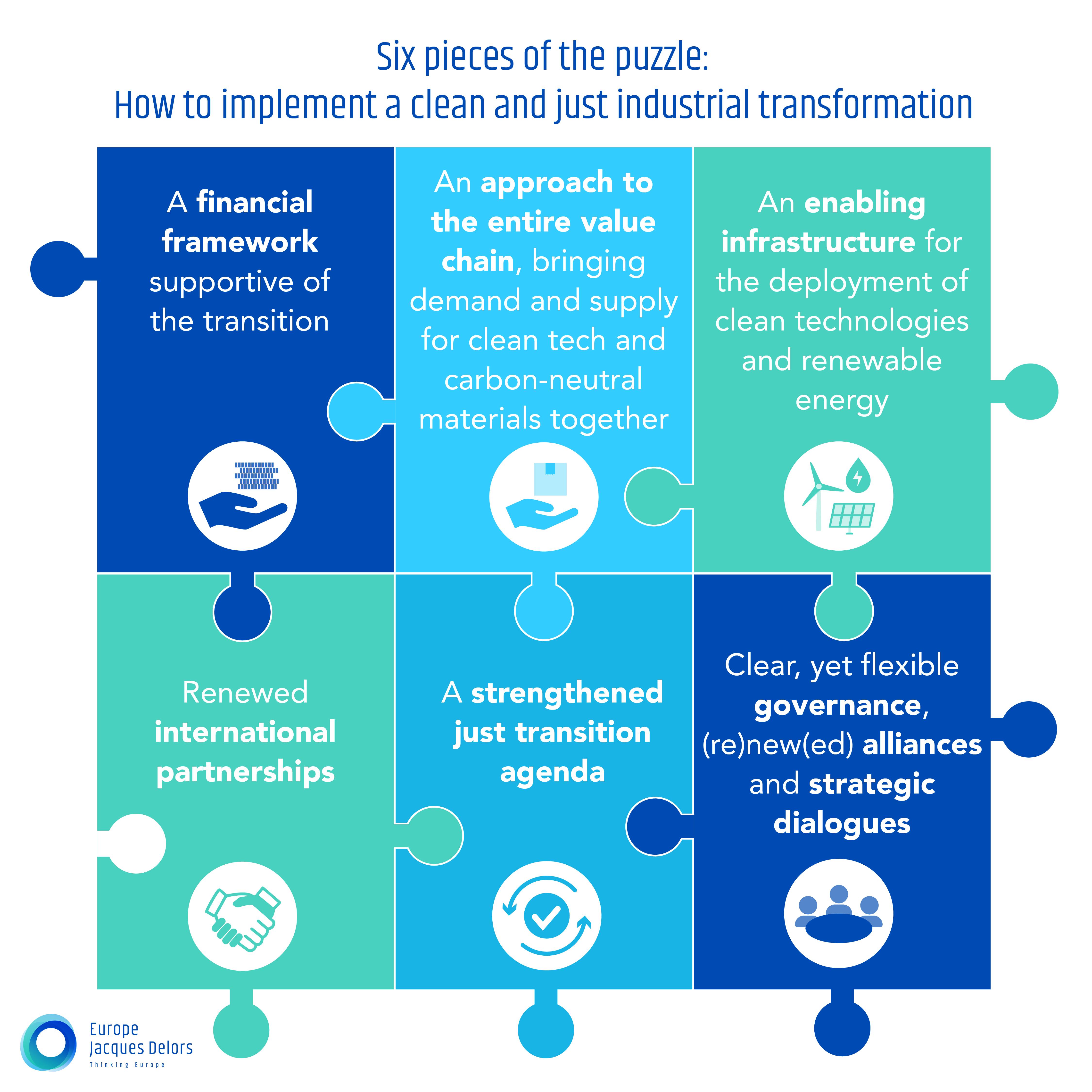
[1] Criscuolo, C., Dechezleprêtre, A.& Lalanne, G. (2023) Industrial strategies for the green transition, Sparking Europe’s New Industrial Revolution, Ed. Tagliapietra, S. & Veugelers, R., Bruegel Blue Print 33
[2] Cf. Batut, C. & Kaiser, J. (2024) À quoi doit ressembler une stratégie industrielle européenne ?, Institut Avant Garde
[3] Cf. Sabato, S. & Vanhille, J. (2024) The European Green Deal and the ‘Leave No One Behind’ principle: state of the art, gaps and ways forward. Study commissioned by the Belgian Federal Minister for Climate, Environment, Sustainable Development and Green Deal in the framework of the 2024 Belgian Presidency of the Council of the EU, OSE Paper Series, Research Paper No. 63, Brussels: European Social Observatory
[4] The current MFF (2021-2027) foresees that at least 30% of the EU budget are spent related to the fight against the climate crisis. Cf. Climate Mainstreaming, European Commission
[5] So far, only Germany has made use of the Hydrogen Bank’s “auction-as-a-service”.
[6] Cf. Eisl, A. (2022) EU industrial policy in the making. Form ad hoc exercises to key instrument: How to make IPCEIs fit for the long run, Policy Paper, Jacques Delors Institute
[7] Von der Leyen, U. (2023, July 18) Europe’s Choice. Political Guidelines for the next European Commission 2024-2029.
[8] Cf. Cornille, J., Delbeke, J., Egenhofer, C., Pandera, J. & Tagliapietra, S. (2024) A Clean Industrial Deal Delivering Decarbonisation and Competitiveness, Policy Paper, Florence School of Transnational Governance, European University Institute
[9] Cf. Agora Industry (2024) Creating markets for climate-friendly basic materials. Potentials and policy options.
[10] E.g. Rodríguez-Pose, A. & Bartalucci, F. (2023) Regional vulnerability to the green transition, Publications Office of the European Union, Bertram, L., Hafele, J., Kiecker, S. & Korinek, L. (2024) A Unified Industrial Strategy for the EU. Industrial Policy Recommendations to Promote Decarbonisation, Competitiveness and Cohesion in Europe, Foundation for European Progressive Studies, Friedrich Ebert Stiftung, and ZOE Institute for future-fit economies, and Makaroff, N. (2024) Poland, a strategic cleantech hub for Europe, Strategic Perspectives







